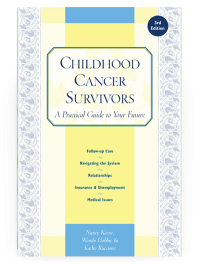Childhood Cancer Survivors
Neuroblastoma
Neuroblastoma is cancer of the sympathetic nervous system—a network of nerves that carries messages from the brain to all parts of the body. Primary neuroblastoma is a solid, malignant tumor that usually first appears as a mass in the abdomen (most often in the adrenal glands) or near the spine.
Approximately 700 children are diagnosed with neuroblastoma each year in the United States, and an additional 65 are diagnosed in Canada. The average age at diagnosis is 2, and two-thirds of newly diagnosed children are younger than age 5. Neuroblastoma occurs slightly more often in boys than in girls. A very small number (1 to 2 percent) of children who are diagnosed with neuroblastoma have a family history of the disease.
Treatment
Treatment of neuroblastoma is based on age, stage of disease, and biologic features and usually includes surgery, chemotherapy, and radiation. The International Neuroblastoma Staging System (INSS) categorizes neuroblastoma into six distinct stages. Most oncologists now also categorize patients into low-risk, intermediate-risk, or high-risk groups and tailor the treatments accordingly.
Surgery
Surgery is used to treat virtually all neuroblastomas and has many important roles. It is used to establish the diagnosis, to obtain tumor tissue for examination, to stage the disease, and for second-look procedures. If the tumor is localized and appears to be removable, surgery is performed soon after diagnosis, before further therapy is begun. Most often, however, this is not possible and chemotherapy is used to shrink the tumor prior to surgery. Even after chemotherapy, surgical removal is often incomplete, and radiation is required to ensure that all tumor cells are destroyed.
The goals of initial surgeries are developed on an individual basis. Factors considered include tumor location, whether it can be removed, relationship to major blood vessels, and the child’s prognosis. Lymph nodes in the area of the tumor usually are sampled to determine whether the disease has spread.
Chemotherapy
Chemotherapy is used to treat almost all children with neuroblastoma. Response rates have improved considerably by using combinations of chemotherapy drugs. The most commonly used chemotherapy drugs include cyclophosphamide (Cytoxanv), carboplatin, cisplatin (Platinol ® ), doxorubicin (Adriamycin ® ), vincristine (Oncovin ® ), ifosfamide, etoposide (VP-16 or Vepesid ® ), and topotecan. For high-risk neuroblastoma, a combination of 13-cis-retinoic acid and GM-CSF is also used.
Radiation
Neuroblastoma is very sensitive to radiation. The primary role for radiation is for local control of tumors that cannot be removed surgically, even after several courses of chemotherapy. Radiation can be used for symptomatic relief of painful bony lesions at any time.
In the past, patients with spinal cord compression were treated with radiation doses of 750 to 3000 cGy. Currently, chemotherapy is used instead, as it has proven to be just as effective with fewer side effects.
Stem cell transplantation
In the last decade, stem cell transplants (i.e., bone marrow, stem cell, cord blood) have been used with increasing frequency to treat children with high-risk or relapsed neuroblastoma. Various regimens are used to prepare the child for transplant. Descriptions of the types of stem cell transplants and their late effects are at the end of this chapter under “Stem cell transplantation.”
Late effects
This section briefly outlines some common and uncommon late effects from treatment. Remember that you may develop none, one, or several of these problems in the months or years after treatment ends.
Surgery for neuroblastoma results in complications in 5 to 25 percent of young patients. The highest rates occur after aggressive attempts to remove abdominal tumors at diagnosis. Long-term effects from these surgeries may include adhesions, injuries to vessels to the kidneys resulting in kidney failure, and neurologic deficits. Surgeries after tumor shrinkage by chemotherapy have much lower complication rates. For more information, see Chapter 15 .
Heart problems. Heart problems can occur months or years after treatment with anthracyclines (i.e., doxorubicin, idarubicin, or daunorubicin), high-dose cyclophosphamide, or chest radiation. Symptoms include shortness of breath, fatigue, wheezing, anxiety, poor exercise tolerance, rapid heartbeat, and irregular heartbeat. Survivors often have no symptoms, but problems may be found on cardiac tests such as echocardiograms, electrocardiograms (EKGs), and Holter monitors. For more information, see Chapter 12 .
Hepatitis C. Infection with the hepatitis C virus can develop in survivors who had blood transfusions prior to July 1992. For more information, see Chapter 15 .
Hearing loss. Cisplatin can cause mild to profound hearing loss in some children. For more information, see Chapter 10 .
Second cancers. An uncommon side effect from treatment of neuroblastoma is developing secondary cancers. For more information, see Chapter 19 .
Opsoclonus-myoclonus syndrome. Patients with neuroblastoma and a syndrome called opsoclonus-myoclonus (also called dancing eyes-dancing feet) have an excellent response to treatment, but they tend to have severe long-term neurologic deficits, including cognitive and motor delays, language problems, and behavioral abnormalities. Although these are not treatment-related effects, they affect quality of life.
The possible long-term effects of stem cell transplants are listed at the end of this chapter under “Stem cell transplantation.”
Table of Contents
All Guides- 1. Survivorship
- 2. Emotions
- 3. Relationships
- 4. Navigating the System
- 5. Staying Healthy
- 6. Diseases
- 7. Fatigue
- 8. Brain and Nerves
- 9. Hormone-Producing Glands
- 10. Eyes and Ears
- 11. Head and Neck
- 12. Heart and Blood Vessels
- 13. Lungs
- 14. Kidneys, Bladder, and Genitals
- 15. Liver, Stomach, and Intestines
- 16. Immune System
- 17. Muscles and Bones
- 18. Skin, Breasts, and Hair
- 19. Second Cancers
- 20. Homage
- Appendix A. Survivor Sketches
- Appendix B. Resources
- Appendix C. References
- Appendix D. About the Authors
- Appendix E. Childhood Cancer Guides (TM)

